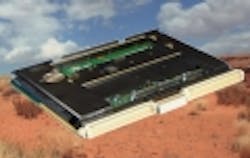Ultra Electronics joins Navy program to develop NGCM submarine torpedo defense system
WASHINGTON, 24 Dec. 2010. Ultra Electronics Ocean Systems in Braintree, Mass., is joining a U.S. Navy program to develop the U.S. Navy's Next-Generation Countermeasure (NGCM) anti-torpedo defense system. Ultra Electronics and the Argon ST subsidiary of the Boeing Co. in Fairfax, Va., will build competing NGCM engineering development models in preparation for a Navy downselect in 2015 to build a final, deployable NGCM system.
Ultra Electronics won a $13.1 million contract Wednesday from U.S. Naval Sea Systems Command in Washington to develop NGCM engineering development models and special test sets. Boeing Argon ST won a similar contract to begin NGCM development under terms of a $16 million contract. The two companies will square off after initial development is finished in 2015 to produce a submarine-deployable NGCM system.
The NGCM is an acoustic torpedo countermeasure with advanced features that function either as static or mobile devices, Navy officials say. The new submarine torpedo defense system will replace the legacy acoustic device countermeasure MK 2 and ME 3 torpedo countermeasures in an attempt to improve Navy submarine defenses against acoustic homing torpedoes.
The NGCM will be a torpedo-like 3-inch diameter acoustic countermeasure designed to defeat threat torpedoes. The anti-torpedo system will be launched from U.S. fast attack and missile submarines in groups of as many as six at a time. The NGCM units will be able to communicate with one another acoustically and act as a group; some will act as stationary broadcast jammers, while others will be mobile sophisticated decoys.
The NGCM units will have receivers able to operate in full-duplex mode with acoustic communications link that pass tactical information and updates among the units, as well as with surface warships and submarines nearby.
The NGCM will be re-programmable to operate cooperatively with U.S. torpedo or anti-torpedo firings, and will be able to change tactics or modes of operation based on changes in tactical conditions or in response to downloaded commands via the acoustic communications links.
Each NGCM unit will have an advanced embedded tactical processor and a threat torpedo classifier built in, and will use its programmed group behavior technology to determine appropriate behavior and responses to rapidly changing tactical conditions.
Ultra Electronics Ocean Systems specializes in undersea defense electronics equipment such as submarine communications, acoustic countermeasures, torpedo defense, anti submarine warfare (ASW), transducers, and special-purpose arrays.
Boeing Argon ST, meanwhile, develops command, control, communications, computers, combat, intelligence, surveillance, and reconnaissance (C5ISR) systems that have powerful sensors and integrated networks. The company was acquired last summer by the Boeing Co. for $775 million, and now is a stand-alone subsidiary of Boeing, and a division of Boeing Network & Space Systems in St. Louis -- a business within the Boeing Defense, Space & Security operating unit.
On the NGCM job, Ultra Electronics engineers will do the work in Braintree, Mass.; Middletown, R.I.; Cambridge, Mass.; and Fairfax, Va., and should be finished by May 2015. Ultra Electronics and Boeing ARGON ST prevailed over three other companies bidding for the NGCM job.
For more information contact Ultra Electronics Ocean Systems online at www.ultra-os.com, Boeing Argon ST online at www.argonst.com, or Naval Sea Systems Command at www.navsea.navy.mil.
